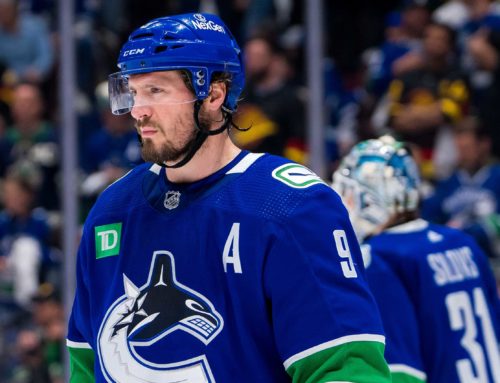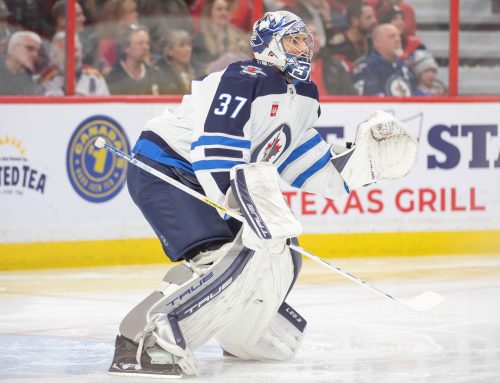Frozen Tools Forensics: Individual Points Percentage
Chris Kane
2024-02-09
Every so often I try to take a moment to pause and make sure to do some deeper dives into some of the numbers we use to assess player performances. In articles I will often refer to underlying numbers and it is often a shorthand way of saying that for each player there are a larger set of indicators we can use to determine whether what we are seeing for them is sustainable or not. We may be talking about shot rates or shooting percentages, or we may be talking about things like team shooting percentages or expected goals. Today we are going to be digging into one of these underlying numbers: IPP (Individual Points Percentage).
I often refer to IPP as a player's point participation number. It describes how many goals a player has gotten a point on while they were on the ice. So if Player A has been on the ice for ten goals and has three goals and two assists, they have pointed on five of ten goals and will have a 50 percent IPP. In general, higher numbers usually correlate with stronger players, in other words, players who are generating more of the team's offense. Let's look at the table below
| Name | Pos | Team | GP | PTS | 3 WK IPP |
| NATHAN MACKINNON | C | COL | 7 | 15 | 78.9 |
| LEON DRAISAITL | L | EDM | 7 | 13 | 81.3 |
| NIKITA KUCHEROV | R | T.B | 6 | 13 | 72.2 |
| DAVID PASTRNAK | R | BOS | 7 | 12 | 80 |
| QUINN HUGHES | D | VAN | 6 | 12 | 80 |
In this table we have the top five scorers over the last three weeks. All have high IPPs – around 80 percent. That means these players have been highly involved in their team's offense. This is a repeatable skill and seeing numbers around 80 percent is pretty typical for top-line elite forwards. That is something to keep in mind with IPP, there are some general expectations we have for this number.
An elite forward might keep up an 80 percent IPP, but a defenseman usually does not. The highest IPP for D men this season (that consistently play and are on the ice for a reasonable number of points) is about 62 percent from Cale Makar and Adam Fox.
Middle six forwards will be a bit lower than the elite forwards, so maybe in the 60-75 range. Middle pairing D quite a bit lower, and so on. These general trends can be helpful, but what makes the most sense is comparing a player to their own personal established history.
If we take that same list and compare IPPs to a larger sample it helps us learn a couple of things.
| Name | Pos | Team | GP | PTS | 3 WK IPP | Season IPP | Δ IPP |
| NATHAN MACKINNON | C | COL | 7 | 15 | 78.9 | 70.8 | 8.1 |
| LEON DRAISAITL | L | EDM | 7 | 13 | 81.3 | 67.4 | 13.9 |
| NIKITA KUCHEROV | R | T.B | 6 | 13 | 72.2 | 79.4 | -7.2 |
| DAVID PASTRNAK | R | BOS | 7 | 12 | 80 | 80.2 | -0.2 |
| QUINN HUGHES | D | VAN | 6 | 12 | 80 | 56.1 | 23.9 |
David Pastrnak has pointed on 80 percent of his team's goals while he is on the ice over the last three weeks (which amounts to 12 points) and that is exactly consistent with his full season numbers. Leon Draisaitl and Nathan MacKinnon have been slightly more involved the last three weeks than they have been overall for 2023-24. Then we have Quinn Hughes, whose 80 percent IPP over the last three weeks is up almost 25 percent from his full season average. That certainly indicates that his 12 points in six games might just be a few too many points. That is obviously an extreme example, as we don't normally expect a defenseman to maintain a 160-point pace.
Let's apply this philosophy to some recently productive players though and see what we can learn.
| Name | Pos | Team | GP | PTS | 3 WK IPP | Season IPP | Δ IPP |
| JAKE DEBRUSK | R | BOS | 6 | 5 | 100 | 55.6 | 44.4 |
| SEAN MONAHAN | C | WPG | 7 | 10 | 100 | 56.5 | 43.5 |
| YEGOR CHINAKHOV | R | CBJ | 6 | 6 | 100 | 60 | 40 |
| ANTON LUNDELL | C | FLA | 7 | 5 | 100 | 62.1 | 37.9 |
| JAKOB SILFVERBERG | R | ANA | 7 | 5 | 100 | 65 | 35 |
This list is all players who have been more involved in the scoring over the past three weeks than typical for the 2023-24 season. On top of that, all of these players have an IPP of 100 percent (which is purely coincidental) meaning if there was a goal scored while they were on the ice, they were a part of it. The general theme here is that we should assume that these close to point-per-game streaks for these players are essentially unsustainable as we are seeing big changes in their personal numbers. Unless of course we can attribute it to something changing on the ice as well.
Anton Lundell is going to be our example here. While we would never expect him to maintain a 100 percent IPP, he did have a change in deployment during a chunk of this period that could help to explain some of this (aside from just straight luck). During a lot of this time he was actually playing in the top six alongside red hot Sam Reinhart. Aleksander Barkov was injured and Lundell was seeing more time with better linemates. More opportunity to get in on more goals. Should we have expected a change in deployment to result in increase in IPP? Not necessarily, but it could certainly be one place to look to determine how his is playing in his new role.
On the flip side, we have a few players who have saw the biggest drop over the last three weeks.
| Name | Pos | Team | GP | PTS | 3 WK IPP | Season IPP | Δ IPP |
| VLADIMIR TARASENKO | R | OTT | 9 | 5 | 38.5 | 64.7 | -26.2 |
| MATS ZUCCARELLO | R | MIN | 6 | 7 | 50 | 68.4 | -18.4 |
| STEVEN STAMKOS | R | T.B | 6 | 6 | 46.2 | 64.4 | -18.2 |
| DRAKE BATHERSON | R | OTT | 9 | 5 | 55.6 | 73.1 | -17.5 |
| MATT BOLDY | R | MIN | 6 | 5 | 45.5 | 62.3 | -16.8 |
Likely this three-week stretch hasn't dramatically changed anyone's perspective of these players, so I am not sure that we really have a 'buy' opportunity or anything like that at this point. In particular, those at the top of this list could see better luck with their participation numbers going forward.
Vladimir Tarasenko leads our list here so it is worth briefly checking in on him. He has largely been playing on a split power-play and with Shane Pinto on what looks like a third line since Pinot's return, though he has had some opportunities with Josh Norris and Tim Stutzle in the top six. Prior to that he had a nice run on a line with Stutzle.
This three-week stretch contains a confusing set of numbers. First up, he has worse deployment and less time on ice. Not great. Then he has a lower shot rate. Also not great. He also has an increased shooting percentage which is fine for getting points over this stretch, but means they might not continue going forward. Finally his IPP is pretty low, which implies he may be due a few more points off of his linemate's goals. Taken all together, some of that IPP returning to normal will be canceled out by his shooting percentage regressing that still likely results in a lower than his current point pace going forward if the changes in deployment stick.
On the season, Tarasenko is on a 60-point pace. While he is on his third line, we may be looking at more like a 50–55-point pace even with these other numbers evening out.
That is all for this week. Do your part to support organizations working to make hockey for everyone.





 BUF
BUF N.J
N.J PHI
PHI MIN
MIN FLA
FLA WPG
WPG VAN
VAN TOR
TOR CGY
CGY DET
DET